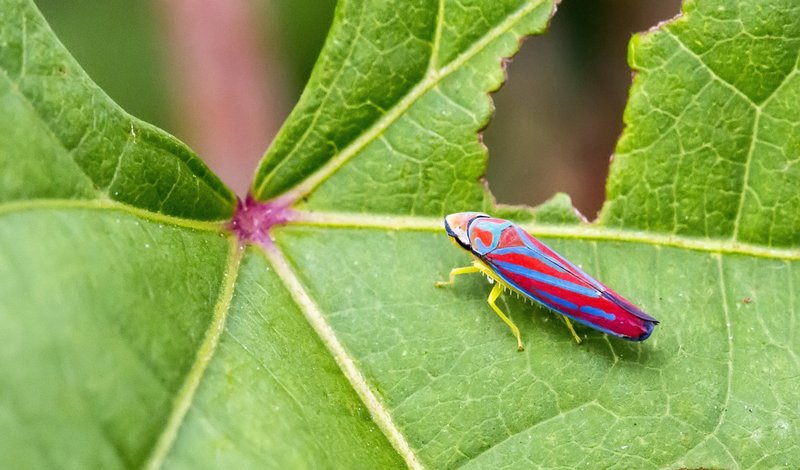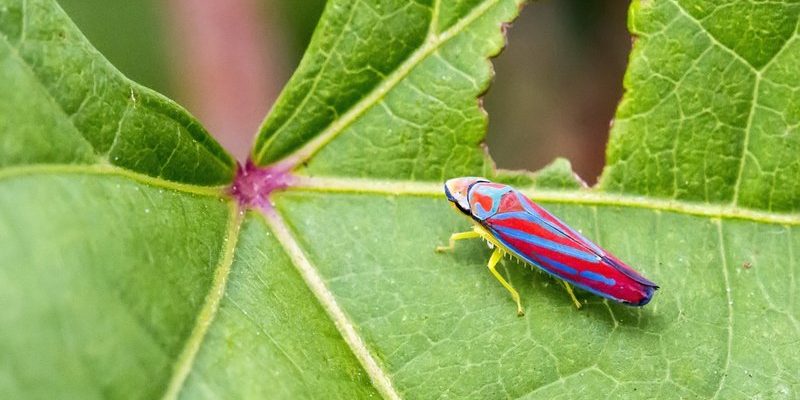
Leafhoppers are small, colorful insects found almost everywhere on the planet. They belong to the family Cicadellidae and are known for their incredible jumping abilities. Just imagine a tiny athlete, leaping effortlessly from one leaf to another! With over 20,000 species worldwide, leafhoppers come in various sizes and colors, often showcasing a bright green or vivid blue hue that helps them blend into their surroundings. This cunning camouflage is just one of the many intriguing aspects of their existence.
You might be wondering how something so small can be so significant in the ecosystem. Well, leafhoppers play an essential role in the food chain. They are food for a variety of animals, including birds, spiders, and even bigger insects. Additionally, they contribute to the health of plants by feeding on their sap. While they may look harmless, some species can cause problems for farmers by spreading diseases to crops. Let’s dive deeper into their world to understand these tiny creatures better.
Physical Characteristics of Leafhoppers
Leafhoppers are relatively small, at about 1 to 10 mm in length. Most of them have elongated bodies and tend to be flattened in shape, which aids in their swift movements across leaves. Their wings are typically held roof-like over their bodies when at rest, creating a unique silhouette that can be both striking and delicate. Some species even display intricate patterns on their wings, which can be a feast for the eyes!
One of the standout features of leafhoppers is their strong hind legs, which enable them to jump great distances. This ability is crucial for escaping predators and navigating their environment. In fact, these little jumpers can leap up to 20 times their body length! If you think about it, that’s like a human jumping the length of a basketball court in a single bound. Think of them as the Olympic athletes of the insect world!
Colors vary widely among species, with some being green to blend in with foliage, while others flaunt shades of yellow, red, or blue to signal danger to predators. This diversity in coloration not only adds to their beauty but also plays a significant role in their survival strategies.
Habitat and Distribution
Leafhoppers thrive in a variety of habitats, from lush forests to arid deserts. They are most commonly found in areas with abundant vegetation, where they can feed on the sap of plants. This makes gardens, fields, and even your backyard perfect spots for encountering these little critters. They prefer sunny environments because warmth helps them stay active, but you’ll also find some species in cooler, shaded areas.
While they are widely distributed across the globe, leafhoppers particularly favor warmer climates. Some species have adapted to live in challenging environments, including wetlands and grasslands. The ability to exploit diverse habitats is crucial for their survival, especially as environmental conditions change.
Data shows that certain leafhopper species are more abundant in specific regions. For instance, in North America, you might stumble upon the “Jassid” leafhoppers, while tropical regions tend to host more unique varieties. This geographic diversity means that wherever you are, there’s likely a leafhopper nearby, contributing to the local ecosystem.
Diet and Feeding Habits
Leafhoppers are primarily sap-sucking insects, meaning their diet mainly consists of plant sap. They use their specialized mouthparts, called stylets, to pierce the plant tissues and extract the sugary fluid. This feeding behavior is essential for their survival but comes with its drawbacks. As they feed, some species can transmit viruses and diseases to plants, causing significant agricultural damage.
Interestingly, leafhoppers are not picky eaters. They can feed on several plant species, from grasses to fruit-bearing plants. This adaptability allows them to thrive in various environments. However, their feeding habits mean they can be seen as pests by farmers, who often deal with their populations in order to protect crops.
Besides plant sap, some leafhoppers also have a relationship with certain fungi, which they can consume for nutrients. This symbiotic relationship showcases the intricate balance of life in ecosystems, where even tiny insects like leafhoppers play a crucial role in nutrient cycling.
Reproduction and Lifespan
Leafhopper reproduction is as fascinating as the insects themselves. Females typically lay their eggs on the underside of leaves, where they remain protected from predators and environmental threats. Depending on the species, a female can lay anywhere from a few dozen to hundreds of eggs in her lifetime. Once the eggs hatch, the nymphs emerge and begin feeding almost immediately, resembling smaller versions of adults.
The lifecycle of leafhoppers generally includes three stages: egg, nymph, and adult. The nymphs grow through several molts before reaching maturity. This process can take anywhere from a few weeks to several months, depending on the species and environmental conditions. During this time, they will continue to feed and grow, often undergoing color changes as they mature.
In terms of lifespan, leafhoppers typically live for about a month or two, though some species can survive longer under ideal conditions. Factors such as temperature, food availability, and presence of predators all influence their life expectancy. Their quick reproductive cycles and adaptability help maintain their populations, even in changing environments.
| Characteristic | Details |
| Size | 1 to 10 mm |
| Color | Green, yellow, red, blue, and various patterns |
| Habitat | Gardens, fields, forests, wetlands, and deserts |
| Diet | Plant sap |
| Lifespan | 1-2 months (varies by species) |
| Reproduction | Eggs laid on leaves; nymphs emerge and feed immediately |
| Jumping Ability | Up to 20 times their body length |
Leafhopper Species and Their Unique Features
With more than 20,000 species of leafhoppers, there’s a lot of variety to explore! Some of the most well-known include the “Cicadellinae,” often recognized for their vibrant colors, and the “Deltocephalinae,” known for their unique shapes and feeding behaviors. Each species has adapted to its environment in fascinating ways, contributing to the rich tapestry of biodiversity.
One particularly interesting species is the “Green Sharpshooter,” which is known for its role in spreading the glassy-winged sharpshooter disease in vineyards. This highlights the dual nature of leafhoppers: while they are beautiful and beneficial in many ways, they can also pose significant challenges to agriculture. Understanding the nuances of different species is essential for managing their populations responsibly.
Species identification can be a fun and educational experience for anyone interested in entomology or simply observing nature. By looking at color patterns, body shapes, and behavior, you can learn to differentiate between various leafhoppers. Just be careful! Some species may be harmful to plants, so it’s best to maintain a safe distance if you’re not sure.
Importance of Leafhoppers in Ecosystems
Leafhoppers may be tiny, but their impact on ecosystems is substantial. They are integral players in the food web, serving as a food source for many predators, including birds and larger insects. By feeding on plant sap, they also contribute to the flow of energy in ecosystems, helping plants maintain their health and vigor.
Moreover, some leafhoppers have a remarkable ability to break down complex plant materials, contributing to nutrient cycling in the soil. This process supports plant growth and fosters healthy ecosystems. Their role as pollinators in some instances, although minor compared to bees and butterflies, cannot be overlooked either. Every insect, no matter how small, has its place in the grand design of nature.
However, the balance can be delicate. When leafhopper populations surge, they can become pests, damaging crops and spreading diseases. This highlights the importance of understanding and managing their populations effectively. Sustainable practices can ensure that we respect these fascinating creatures while protecting our agricultural interests.
Threats and Conservation
While leafhoppers are adaptable, they face threats due to environmental changes and agricultural practices. Habitat destruction, often caused by urbanization and intensive farming, can reduce their populations. Pesticide use also poses significant risks, not only to leafhoppers but to the entire ecosystem. It’s crucial to find a balance between agricultural needs and the preservation of these tiny insects.
Conservation efforts for leafhoppers primarily focus on protecting their habitats and promoting sustainable farming practices. By maintaining natural vegetation and reducing pesticide use, farmers can create environments where leafhoppers can thrive without causing harm to crops. Integrated pest management strategies can help balance agricultural productivity with ecological health.
Continued research is essential to understanding leafhopper populations and their roles in ecosystems. Citizen science initiatives encourage people to observe and report leafhopper sightings, contributing valuable data that can inform conservation strategies. As we learn more about these fascinating insects, we can better appreciate their importance and work to protect their habitats.
FAQ
What do leafhoppers look like?
Leafhoppers are typically small, ranging from 1 to 10 mm in length. They have elongated bodies and are often brightly colored, featuring greens, yellows, and blues. Some species show unique patterns on their wings, making them visually stunning. Their wings are held roof-like over their bodies when at rest, contributing to their distinctive appearance.
Are leafhoppers harmful to plants?
Yes, some leafhopper species can be harmful to plants. They feed on plant sap, which can weaken plants and lead to stunted growth. Additionally, certain leafhoppers are vectors for plant diseases, spreading viruses that can devastate crops. However, not all species are harmful, and many play beneficial roles in ecosystems.
How do leafhoppers reproduce?
Leafhoppers reproduce by laying eggs on the underside of leaves. After the eggs hatch, the nymphs emerge and begin feeding almost immediately. The lifecycle includes three stages: egg, nymph, and adult. This process allows them to mature quickly and maintain their populations.
How do leafhoppers jump so far?
Leafhoppers have strong hind legs that allow them to leap great distances, up to 20 times their body length! This remarkable ability helps them escape predators and navigate their environment quickly. Imagine being able to jump the length of a basketball court in one bound—that’s how impressive their jumping skills are!
What do leafhoppers eat?
Leafhoppers primarily feed on plant sap, which they extract using specialized mouthparts called stylets. They can feed on a wide variety of plants, making them adaptable in different habitats. Their feeding habits can sometimes harm plants, but they also contribute to the health of ecosystems.
Where can I find leafhoppers?
Leafhoppers can be found in diverse habitats, including gardens, fields, forests, and even deserts. They prefer sunny areas where vegetation is abundant. You might spot them resting on leaves or jumping away quickly as you approach!
How long do leafhoppers live?
Leafhoppers typically live for about one to two months, although the lifespan can vary based on species and environmental conditions. Factors like temperature, food availability, and predation all influence how long these tiny insects can survive.
Why are leafhoppers important to ecosystems?
Leafhoppers play a significant role in ecosystems as they are part of the food web, serving as prey for various animals. They also contribute to plant health by feeding on sap, and some species help with nutrient cycling in the soil. Their presence is vital for maintaining balanced ecosystems.
Can leafhoppers be beneficial?
Absolutely! While some leafhopper species can be pests, many contribute positively to their ecosystems. They help with nutrient cycling, serve as food for predators, and can even assist in pollination. Understanding their roles can help us appreciate their importance beyond their occasional status as pests.
How can I manage leafhopper populations in gardens?
To manage leafhopper populations in gardens, consider implementing integrated pest management strategies. This includes using physical barriers, promoting beneficial insects, and practicing crop rotation. Creating a healthy garden ecosystem will naturally keep leafhoppers in check while minimizing the use of harmful pesticides.
What makes leafhoppers unique among insects?
Leafhoppers are unique due to their impressive jumping abilities, vibrant colors, and adaptability to various environments. Their complex lifecycles and interactions with plants showcase the diversity of life in ecosystems. Plus, their ability to rapidly reproduce allows them to thrive in changing conditions, making them truly fascinating insects!

